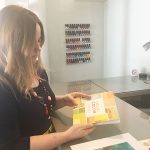The weather is warming up and the blooms are… well, blooming. It gives people a…
6 STEPS TO PERFECT HAIRCOLOR

Looking to refine your color skills? Consider these 6 Steps before you start your next color project. See links below for more helps.
(Not a professional? There’s more to this whole color thing than meets the eye. It’s not only an art, it’s also a science. Feel free to share this post with your favorite pros, and then let them handle it from there.)
#1 What is the client’s color objective?
Understanding the client’s overall, long-term plan for their hair may affect what you do for the current appointment. Do they change their color often? Do they like to go darker in the fall and lighter in the spring? The more you can clarify and pin down what they are really hoping for long-term, the more informed your decision making will be for the current appointment, and the more successful you will be overall.
#2 What is the client’s natural hair color level?
An often-overlooked step, the natural level is critical to correct formulation. You need the level to be accurate in order for your process to be accurate. (See further information & a video link below about finding the correct level.)
#3 What is the client’s cosmetic color level?
Knowing the current level of the previously colored hair (and the hair history in general) is another important piece in determining your formula. In most cases, your client will have several cosmetic levels throughout the hair. Make sure you know what each one is. For example, do you see any dark bands? Are the ends too light? Are there spots that were previously missed during the last color service? If you correct these (by removing tone, diffusing a dark band, or filling hair that’s too porous or too light), then your end result will be not just good, but perfect. Addressing the subtle issues throughout the hair, instead of only focusing on the main objective, is the mark of a great colorist.
#4 What is the client’s grey hair percentage?
Overlooking this step can give a color result that looks “hollow” or “hot” (and not in a good way). After identifying the grey hair percentage, adjust your formula based on your manufacturer’s recommendations. If the grey is concentrated in specific areas, you may need more than one color formula to address the pigmented and the non-pigmented hair differently.
#5 Does the color objective require lifting, tone-on-tone, darkening, or a combination of these?
If you work this out in your head before you start, you will have a clear cut plan. This information will determine if you will use lightener, permanent color, demi-permanent color, or even semi-permanent color. It will also help you decide which level of developer will be needed to achieve the end result.
#6 What is the contributing pigment?
Contributing pigment will build the foundation for your color. For example, if your end goal is to be a dark copper tone, the ideal underlying pigment to support that color would be orange. If you were to put that dark copper straight over a pale yellow contributing pigment, it’s going to looked washed out and hollow, instead of rich and vibrant. And it probably won’t have the staying power you hope for. On the other hand, if you want to neutralize the contributing pigment and have a cool tone result, you need to know exactly what that tone will be so you can correctly pick the right shade to neutralize it, or cool it down.
Identifying these six things before you start each color service will make you a more skilled and successful colorist. If you’re just starting out with these steps, I recommend writing this information down for each client. Be specific. (Bonus: Download my “6 Steps to Perfect Color” consultation form below.) Once you’ve done it in writing for a while, you will find that it becomes second nature. Even if you’re more familiar with the steps, I still recommend making a note of each client’s natural level, previously colored level, and what you did in your client records. This way, when your client comes back for something different, or for a touch up, it will be easy to get started again.
·····························
Further information about “Finding the Level.”
Like many colorists, I like to play the “guess my level” game when I’m formulating color. “It looks like she’s a level X.” Sound familiar? What you might not expect is, I also check myself against the level system for the line we are using. Yes, every time we start a new client formulation (or a new formulation on an existing client), I pull out the level swatches. And so do the stylists at my salon. It only takes a few seconds to verify that your guess was 100% accurate. And then you can celebrate your genius. But honestly, a lot of stylists are not as good as you at the guessing game. And so many of them feel it’s a badge of courage to guess the level without checking. Being 100% accurate every single time can be the difference between good color and great color.
Another thing to keep in mind about levels: Every once in a while I have a client who is truly somewhere between two different levels. For example, not quite a 4, but also not quite a 5. More like a 4.5 level. If that’s the case, I address them as the lower level. But generally, most people can match to a whole number. As an educator and a salon owner, I have often found that when stylists can’t decide between two levels, it’s not because their client’s hair is unique, but rather because they aren’t confident in their level finding skills. That’s okay. We all question ourselves sometimes. But really understanding how to find the correct level will give you added confidence when you formulate, and will help you achieve those perfect color results you want. Invest those few seconds up front, and save yourself time in the end.
·····························
Watch my level finding video here.
Download my Perfect Haircolor Consultation Form here.
You can make a copy for each client, or laminate it and use a grease pencil or whiteboard marker to walk through the steps during each color consultation, and then take a picture for your client files before you erase it.



